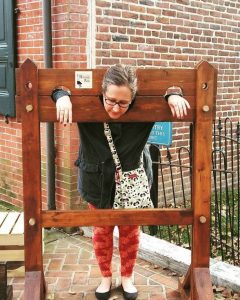Visit the John Bell House to find out more about how diseases like smallpox were managed during the American Revolution.
DOVER – DNREC’s First State Heritage Park will feature “Science Exploration” as the theme August 4 for the First State Heritage Park’s monthly “First Saturday in the First State,” with a variety of free events and activities.

The John Bell House will feature “Revolutionary Medicine,” a program offered throughout the day about what medicine was like in the 18th century. Join historical interpreters in colonial clothing to learn about how Revolutionary War soldiers were treated for smallpox and other diseases. Visitors also will be able to play the role of a bio-archaeologist to help determine the cause of death for theoretical remains based solely on what can be found using archaeology.
Dr. Stephanie Holyfield will present “Colonial Contagion: Smallpox and the American Revolution,” at the Delaware Public Archives. Dr. Holyfield will discuss the impact of the disease and present information about the history of smallpox in the colonial era, George Washington’s decision to inoculate the army, and how the epidemic threatened the outcome of the war.
At 11 a.m., The Old State House will host “Medicine through the Wars: The Evolution of American Wartime Medicine.” From the American Revolution to present, find out how warfare – despite its destructive nature – has led to great advancements in science, especially in medicine.
Social science is the subject at the Kent County Courthouse, where visitors will participate in “Crime and Punishment” to learn how justice was served in the 18th century. The newly constructed pillory and stocks will be on display for visitors to try them on for size.
Here is a list of programs and activities for First Friday and First Saturday in the First State:
First Saturday – August 4
9 a.m. – 4:30 p.m.
Revolutionary Medicine — John Bell House on The Green, 43 The Green
Learn about 18th century medicine and how the inventions of Dover’s own Dr. James Tilton saved lives during the Revolutionary War.
A Capitol Experience — Legislative Hall, 411 Legislative Avenue
Tour Delaware’s State Capitol building, and experience Delaware history. Photo ID is required for all adults entering the building.
Biggs Kids: Bird Prints — Biggs Museum of American Art, 406 Federal Street
Help welcome our visiting flock of John James Audubon bird prints with a special bird craft. Feathers will fly! For ages 5-10.
10 a.m. – 1 p.m.
Tours of the Governor’s House — Woodburn – The Governor’s House, 151 King’s Highway
Enjoy guided tours of the official residence of Delaware’s Governor since 1965, and Hall House, the Governor’s guest house.
10 a.m. – 3 p.m.
Sickness and Health…and the Occasional Poisoning Walking Tour — John Bell House on The Green, 43 The Green
Highlighting stories of medical curiosities of Dover’s past.
10:30 a.m.
Colonial Contagion: Smallpox and the American Revolution — Delaware Public Archives, 121 Martin Luther King, Jr. Blvd.
Dr. Stephanie Holyfield will discuss the impact of smallpox during the American Revolution with information about the history of the disease, epidemic threats, and George Washington’s decision to inoculate soldiers against the disease.
11 a.m.
Medicine Through the Wars: The Evolution of American Wartime Medicine — The Old State House, 25 The Green
This lecture examines the progress made in military medical practices and the role Delawareans played from the American Revolution through World War II.
1:30 – 4 p.m.
Crime and Punishment in the 18th Century — Kent County Courthouse, 38 The Green, Courtroom #1
From the pillory to the gallows, learn how justice was served in the 18th century, and how American colonists showed mercy to criminals in surprising ways.
1:30 p.m.
Sound, Stage, and Screen — Johnson Victrola Museum, 375 S. New Street
Examine the science behind adding recorded sound to film and how that revolutionized the industry.
Each month during “First Saturdays in the First State,” the First State Heritage Park offers a variety of free programs at each of the park’s partner sites, including tours of the two capitol buildings in Delaware’s capital city – the Old State House and Legislative Hall – hourly walking tours leaving from the John Bell House, and the monthly “Biggs Kids” program at the Biggs Museum of American Art. Exhibits are also on display at the Biggs Museum, the First State Heritage Park Welcome Center and Galleries, and the Johnson Victrola Museum.
Admission to all park sites and programs is free. Centrally-located free parking is available at the First State Heritage Park Welcome Center and Galleries, located at 121 Martin Luther King Jr. Boulevard North. For more information about “First Saturday” events and all First State Heritage Park programs, please call 302-739-9194 or visit the First State Heritage Park web site.
The First State Heritage Park is Delaware’s first urban “park without boundaries,” linking historic and cultural sites in the city that has been the seat of state government since 1777. The park is a partnership of state agencies under the leadership of DNREC’s Division of Parks & Recreation, working in collaboration with city and county government, nonprofit organizations and the private sector.
Contact: Sarah Zimmerman, DNREC Division of Parks & Recreation, First State Heritage Park, 302-739-9194 or sarah.zimmerman@delaware.gov.